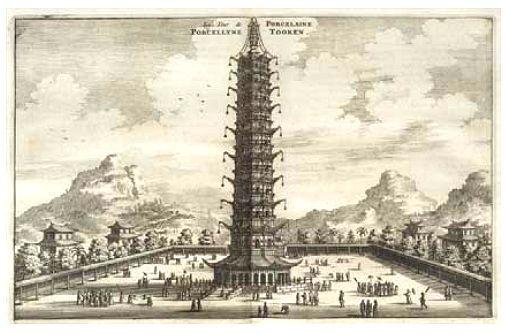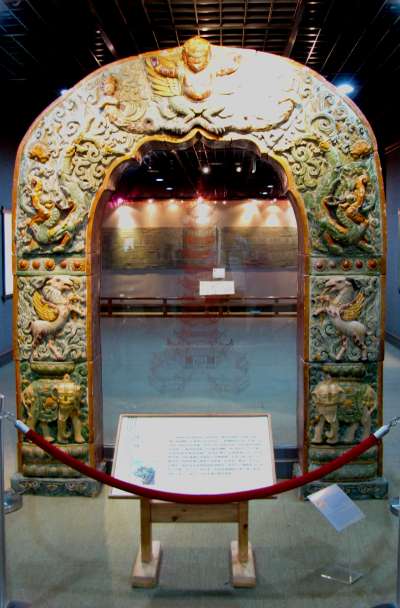
THE PORCELAIN TOWER Jean Nieuhoff (1618-1672) Etching with engraved details. Plate taken from the book The embassy of the Dutch east India Company to the emperor of China, or the Great Cam of Tartary; Leiden, J. De Meurs, 1665.
This etching of the pagoda at Nanjing had a considerable impact on European readers, thanks to the broad distribution of Nieuhoff's work, first published in 1665. The nine storeys of the tower with their characteristic curling eaves, as well as the roof of the pagoda, were adorned with porcelain panels which left an indelible mark on European imaginations. The most obvious expression of this impact was the decoration of the Trianon de Porcelaine, constructed in 1670 by Louis Le Vau. While the architecture of the Trianon Palace bore no trace of Chinese influence, the idea of covering the walls, the cornices and the fountains in the gardens with porcelain-like tiles and vases was directly inspired by the Nanjing pagoda.
The Porcelain Tower of Nanjing was erected during the reign of the Yongle Emperor (1360-1424), and was a well-known landmark in China. To Western visitors this tower became so synonymous with Chinese architecture that its distinctive outline became a recurring leitmotif in European artworks which sought to emulate Oriental styles.
One of the most famous imperial projects of the early Ming dynasty was the porcelain pagoda known as Bao'ensi, which means 'Temple of Gratitude', familiarly known to Westerners as the Porcelain Pagoda and ranked as one of the seven wonders of the medieval world. Begun in 1412 and completed in 1419, it was built by the Yongle emperor (1402-1424), a devote Buddhist, at Jubaoshan, on the outskirts of Nanjing, to honor his deceased parents.
The pagoda was octagonal with a base of about 97 feet in diameter and adorned with 128 lamps hung on it to illuminate the tower at night. Glazed tiles and white porcelain that reflected the sunlight was combined into the walls to create a mixture of green, yellow, brown and white designs on the sides of the tower, including animals, flowers and landscapes. The tower was also decorated with numerous Buddhist images. While the white porcelain bricks was made in Jingdezhen, the polychrome brickwork (liu li was manufactured at a tile work nearby). Of this some sections such as one portal have been saved and reconstructed, to be currently on display in the Nanjing museum.

The salvaged and reconstructed entrance of the Porcelain pagoda - Bao'ensi. Nanjing museum.
It was constructed in the 15th century as a Buddhist pagoda, but was plundered and destroyed in the l9th century in the course of the Taiping rebellion, however the pagoda is now under reconstruction.
At its time, the pagoda was one of the largest buildings in China, rising up to a height of 260 feet with nine stories and a staircase in the middle of the pagoda, which spiraled upwards for 130 steps. The top of the roof was marked by a golden sphere.
In 1801 a bolt of lightning struck and knocked off the top three stories of the tower, but it was soon restored. In the 1850s the area surrounding the tower erupted in civil war as the Taiping Rebellion reached Nanjing the Buddhist images was smashed the inner staircase was destroyed. In 1856 during the course of the Taiping rebellion the pagoda was completely destroyed and plundered. After this point, the tower's remnants were forgotten and it lay dormant until a recent surge to try and rebuild the landmark.
In Granville Gower Loch, The Closing Events of the Campaign in China, 1843, the following text appears as Appendix, p 203-206.
PORCELAIN PAGODA.
COMPILED FROM A COLLECTION OF SKETCHES BY KINLUNG (Qianlong), IN WHICH IS A REPRESENTATION OF A TEMPLE DEDICATED TO THE HONOUR OF BUDDHA.
That at as remote a period of the world as the reign of Sun Woo, the great Emperor, this temple was erected, and at successive periods additions and repairs were made from time to time. Originally the temple occupied a small square space of ground called Soo-Leung, but the priest Lew-Lung, O, obtained a grant of land, in extent 1000 le, within which space its limits were to be confined.
The Emperor Wan-te, of the Tsin dynasty. having at this time made an addition to it, it took the name of Chang-Tseen-Sze, and during his reign it was raised to the height of three stories.
In the reign of Kaon-Tsung (or the first emperor), of the Tung dynasty, extensive repairs were made, and the name altered to Teen-He-Sze (the temple-the delight of heaven). In the reign of Kien-Tih, the founder of the Sing dynasty, the name was altered to that of Teze-Gan-Tsung-Chung (the temple conferring favours, imparting faith and charity).
During the reign of Yung-Lo (eternal joy) the Empress caused to be commenced the northern wall of the enclosure as an offering, and the work continued till the lst day, 8th moon, 6th year of Seun-T1'h-a period of 19 years.
The boards of works then caused a detailed plan of the structure to be printed; its height being 32 changs * (* A chang is thirteen feet) , 9 covids, 4 puntos, and 9-l0ths of a punto, and its roof surmounted by a ball, both of which were covered with brass plates of an endless brightness. On the roof of the ninth story project dragons' heads, in whose mouths are attached ten chains which ascend to the apex of the roof ; each having 72 links: above and below, at the eight corners, the chains amount to 80 in number, making a total of 152 ; while on the outside of the nine stories there are stands or supports for 128 lamps ; within, each chamber, and also the centre of the roof, are supplied with glazed horn lanterns ; the quantity of oil required to fill them being 64 catties (81 1bs.), and the brilliant appearance they create ascends to the heavens. The apex is surmounted by a copper ball, whose weight is 900 catties (1200 lbs.): it contains a dish for sacrifice, and it is of the weight_of 450 catties (600 lbs.).
From the east, looking towards the sea; from the south, where is the garden of the Tung-Foo ; towards the west, where is the bridge called the Le-pin ; and towards the north, where is the great river (Yang-tze-kiang), the distance is 9 le, 13 poos (about 2 1/2- miles).
From the reign of Yung-Lo, when it underwent a thorough repair, an hundred ages have experienced its benefits, protection, and favour ; it is therefore called Paon-Gan-Sze (the temple of the protecting favour). From the first story throughout the building, the whole cost of labour has amounted to 2,485,484 tales (equal to about 3 1/2 millions of dollars). On the roof stretching up to the apex are nine iron rings, the largest of which is 6 changs 3 covids (about 75 feet) in circumference, and the smallest 2 covids 4 puntos, the entire weight being 3600 catties (4800 lbs).
It has a beam in the roof which shines during the darkest night ; one that keeps off danger from fire ; another from water ; and one that defends it from the violence of the winds ; while a fifth guards against the effects of earthquakes. In the same place, the roof, there is a gold rod of the weight of 40 tales, tea leaves one bushel, silver 1000 tales, a mirror weighing 100 catties, a gem of great value, cash of the reign of Yung-Lo, 1000 strings, silk of the Imperial yellow two pieces, one collection of the chemical works of the king, or holy book of Fo, one copy, and two or three treating of the religion of Buddha ; - all these relics are in the roof.

Bao'ensi or the Porcelain Tower of Nanjing, 19th Century, in ink and colour on silk, framed and glazed 39 1/4 in.x 20 1/2 n. (99.6cm.x 51.5cm.) inscribed with the history of the pagoda which was built in the early 15th century during the reign of the Yongle Emperor and refurbished during the 7th year of the Jiaqing period (1802) along with a description of the building including its height and contents, signed and with one seal. Christie's Chinese Ceramics, Works of Art and Textiles sale, the 14 May 2010, London, South Kensington, this painting, of
Now in the 5th year of the reign of Kea-king, during the 5th moon, 15th day, the God of Thunder caused it to be injured in three places, and at the same time the whole of the nine stories received damage. Really was the strength of the gods manifested with fearful awe and severity: the idols (not being susceptible to injury from causes which affect material objects) were untouched.
The governor and Foo-Yeun (deputy-governor) then in a clear and luminous communication represented to the throne the extent of the disasters, and solicited workmen to repair it. In the 7th year of Kea-king, 2d moon, 6th day, they commenced, and having thoroughly repaired and beautified the temple, they ceased work on the 2d day of the 6th moon, since when it has undergone no change.
After noticing that this all is taken from a description publicly displayed in the Pagoda, it is hard to not wonder if the disaster and ultimately destruction of this pagoda was due to some attempt to first protect and second to get at, the treasures in the roof.
Jan-Erik Nilsson
A